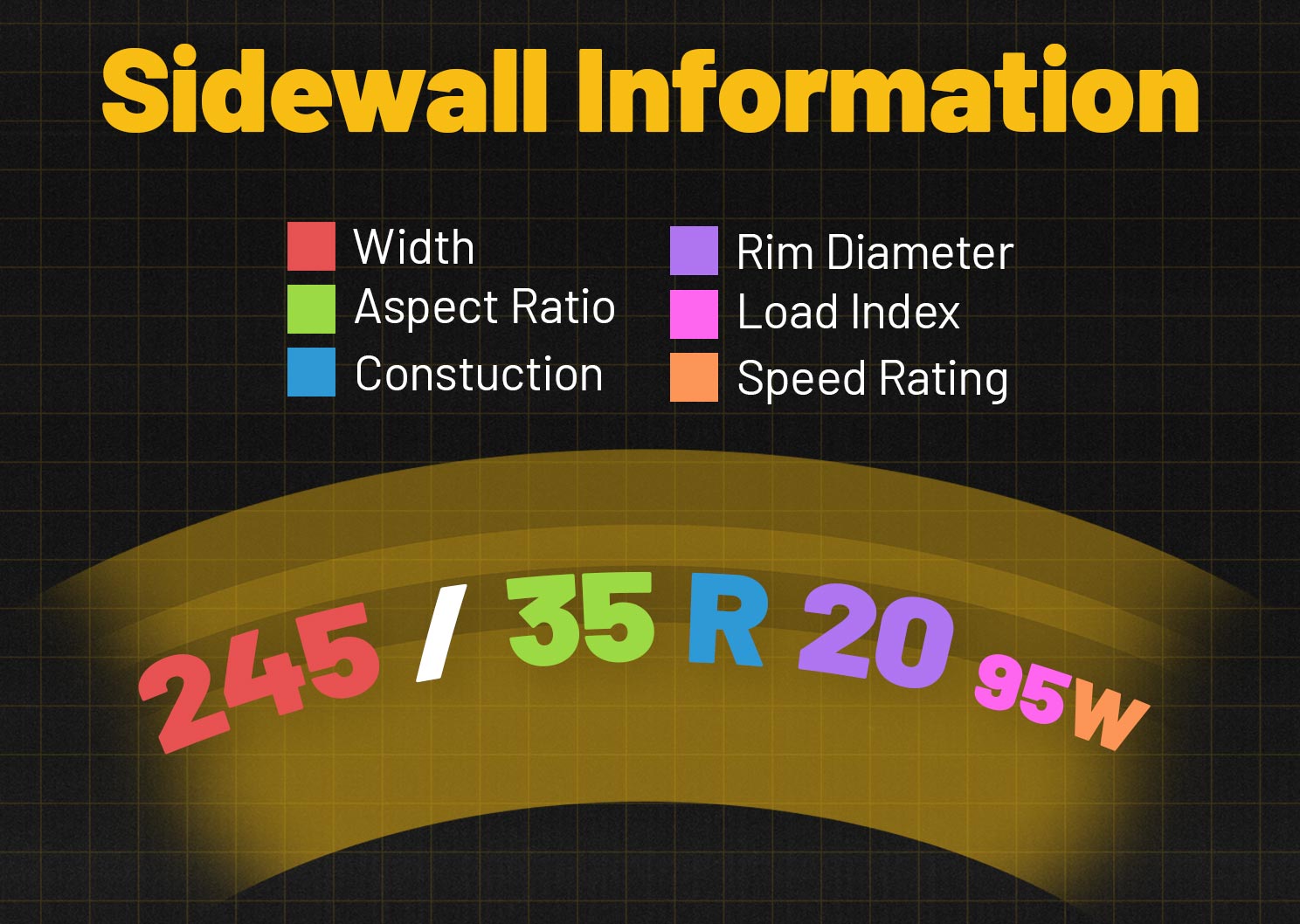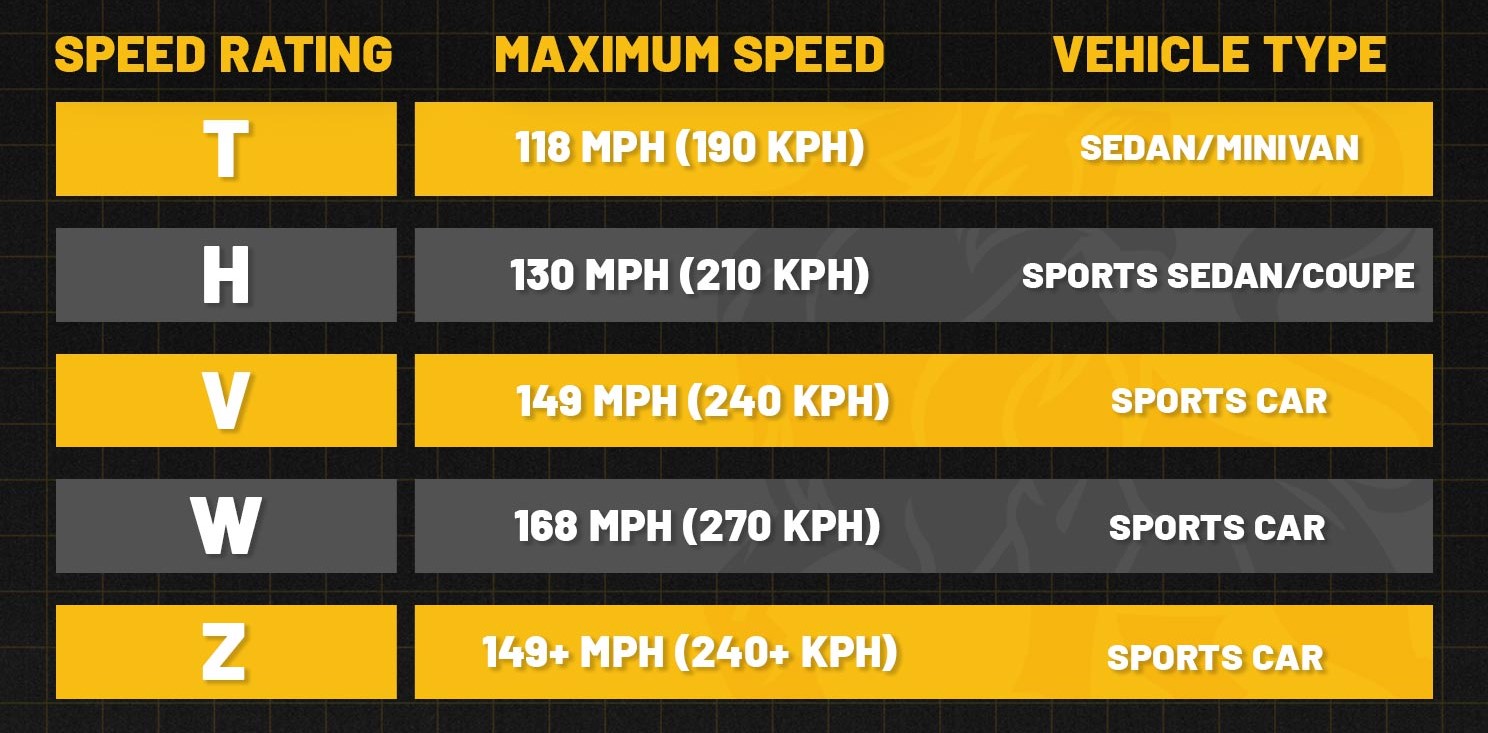Understanding Tire Speed Ratings
What Is Tire Speed Rating?
As previously stated, a tire’s speed rating indicates the maximum speed that a tire can safely maintain over time. In other words, it is the fastest speed that a tire can handle before it no longer performs as intended. The higher the speed rating, the better control and handling a driver will have at higher speeds.
The speed rating system was established to help regulate the safe performance of tires at standardized speeds. A tire’s certified speed rating is denoted by a letter from A to Z, with A being the lowest rating and Z being the highest. This rating system indicates the maximum speed for which a tire is certified. However, this rating does not indicate the total performance capability of a tire.
How to Find Tire Speed Rating
If you are unsure what tire speed rating your vehicle manufacturer recommends, there are few places on the vehicle to find speed rating information. To determine the tire speed rating recommended by your vehicle manufacturer, simply look through your owner’s manual. This information can also be found in the driver’s side door jamb. On older vehicles, recommended tire speed ratings can also be found in the gas tank hatch or inside the glove box door.
Additionally, speed ratings can be found on the tire itself. Speed rating is easy to locate because it is usually the last item in the character sequence in the tire’s size code. For example, a “245/35R20 95W” has a speed rating of W. The numbers before the W indicate the tire’s load rating. In this example, this specific tire has a speed rating of W, which is rated for 168 mph, or 270 kph.
To find the tire size code on your current tires, read the sidewall. It is important to make sure that the speed rating of your tires match what the manufacturer recommends. It is also important to note that the speed rating is not the same as the recommended travel speed. The rating will almost always exceed the maximum highway speed limit, but no tire or vehicle manufacturer recommends driving faster than the law allows.

Determining Speed Ratings
Speed ratings are assigned to tires based on their performance in laboratory tests. These tests simulate real-world driving conditions, including different speeds and loads. To receive a speed rating, a tire must demonstrate that it can safely withstand the forces associated with that speed.
However, it’s important to remember that laboratory tests can’t account for every possible condition that a tire might encounter on the road. For example, a tire’s speed rating may not be accurate if the tire is underinflated, damaged, or overloaded. Additionally, the speed rating may not be applicable if the tire is used in extreme weather conditions or if it is driven for long periods of time at high speeds.
As a general rule, it’s best to avoid driving at speeds above the speed rating of your tires. If you must drive at higher speeds, be sure to check your tire pressure regularly and inspect your tires for signs of wear or damage.
Peculiarities of the Tire Speed Rating System
The speed rating system for tires uses letters from A to Z, with higher letters corresponding to higher speeds. However, there are some quirks in the system, such as the letter H being out of place. Additionally, some speed ratings do not exist, such as I, O, and X. When the system was first developed, the highest speed rating was V, which was for tires with a maximum sustained speed of 149 mph. However, as tires with higher speeds were developed, the W and Y speed ratings were added. Today, the Z rating is used for tires with speeds over 149 mph, and some manufacturers will insert a Z in the tire size description to indicate this.
Commonly Found Tire Speed Ratings
The following are the most common speed ratings for ordinary vehicles, starting with a maximum speed of 118 mph (190 kph) and increasing from there. Each rating is denoted by a letter and corresponds to a specific speed.

Speed Rating T
Tires with a “T” speed rating are typically found on family sedans and minivans, as they can withstand speeds of up to 118 mph.
Speed Rating V
The letter “V” used to represent a maximum speed of 149 mph (240 kph) or more, making it the highest speed rating for a tire. However, it now only represents a maximum speed of 149 mph, with higher speeds requiring a different letter rating.
Speed Rating W
Tires with a “W” speed rating, a relatively new addition to the speed rating chart, can sustain speeds of up to 168 mph (270 kph).
Speed Rating H
As mentioned above, the “H” speed rating does not appear after “G” but instead between “U” and “V”. This rating represents a maximum speed of 130 mph, or 210 kph, and is most common;y found on sports sedans and coupes. Earlier variations of the “H” rating stood for “high performance”, which is why it has an unusual position in the speed rating chart today.
Speed Rating Z
The rating “Z” is almost always reserved for high-performance sports cars. In some cases, the “Z” rating can sometimes appear in the middle of a tire’s size information denoted on the sidewall. When this happens, it represents either a maximum speed of more than 149 mph (240 kph) or 186 mph (300 kph). The specific speed that a Z-rated tire can handle will depend on the tire itself. Contact the manufacturer for more information on Z-rated tires. Sports car owners are more likely to need Z-rated tires than owners of typical family sedans.
Tire Speed Rating Chart
| Rating | MPH | KPH |
|---|---|---|
| A1 | 3 | 5 |
| A2 | 6 | 10 |
| A3 | 9 | 15 |
| A4 | 12 | 20 |
| A5 | 16 | 25 |
| A6 | 19 | 30 |
| A7 | 22 | 35 |
| A8 | 25 | 40 |
| B | 31 | 50 |
| C | 37 | 60 |
| D | 40 | 65 |
| E | 43 | 70 |
| F | 50 | 80 |
| G | 56 | 90 |
| J | 62 | 100 |
| K | 62 | 110 |
| L | 75 | 120 |
| M | 84 | 130 |
| N | 87 | 140 |
| P | 94 | 150 |
| Q | 100 | 160 |
| R | 106 | 170 |
| S | 112 | 170 |
| T | 118 | 190 |
| U | 124 | 200 |
| H | 130 | 120 |
| V | 149 | 240 |
| Z | 149+ | 240+ |
| W | 168 | 270 |
| (W) | 168+ | 270+ |
| Y | 186 | 300 |
| (Y) | 186+ | 300+ |
Always choose the speed rating that matches your vehicle manufacturer’s specifications, and make sure all four tires have the same rating. Speed ratings are based on laboratory tests conducted under specific, controlled conditions. While these tests are relevant to performance on the road under those conditions, remember that real-world driving is rarely identical to test conditions.
Basic Tire Maintenance
- Regularly rotate your tires.
- Check your tire pressure every month or before a long trip.
- Inspect your tires for signs of wear and tear, such as uneven wear, bulges, and cracks, at least once a month.
- Regularly have your tires aligned and balanced.
- Avoid driving on underinflated tires, as this can cause uneven wear and tear, poor fuel economy, and a greater risk of a blowout.
- Avoid driving on rough roads, as this can also cause uneven wear and tear.
- Avoid driving through puddles or standing water, as this can cause hydroplaning.
- Store your tires properly when they are not in use, such as in a cool, dry place.

